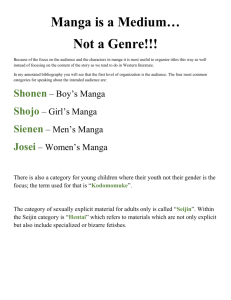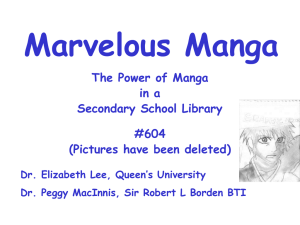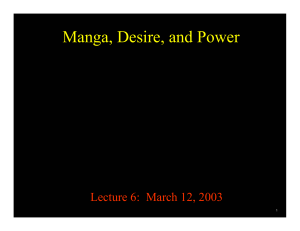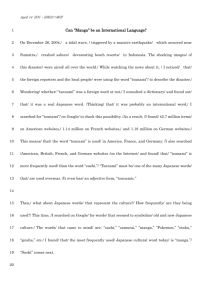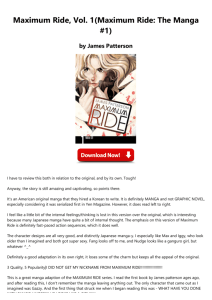Gaze Pattern Analysis to Detect Manga Similarity
advertisement
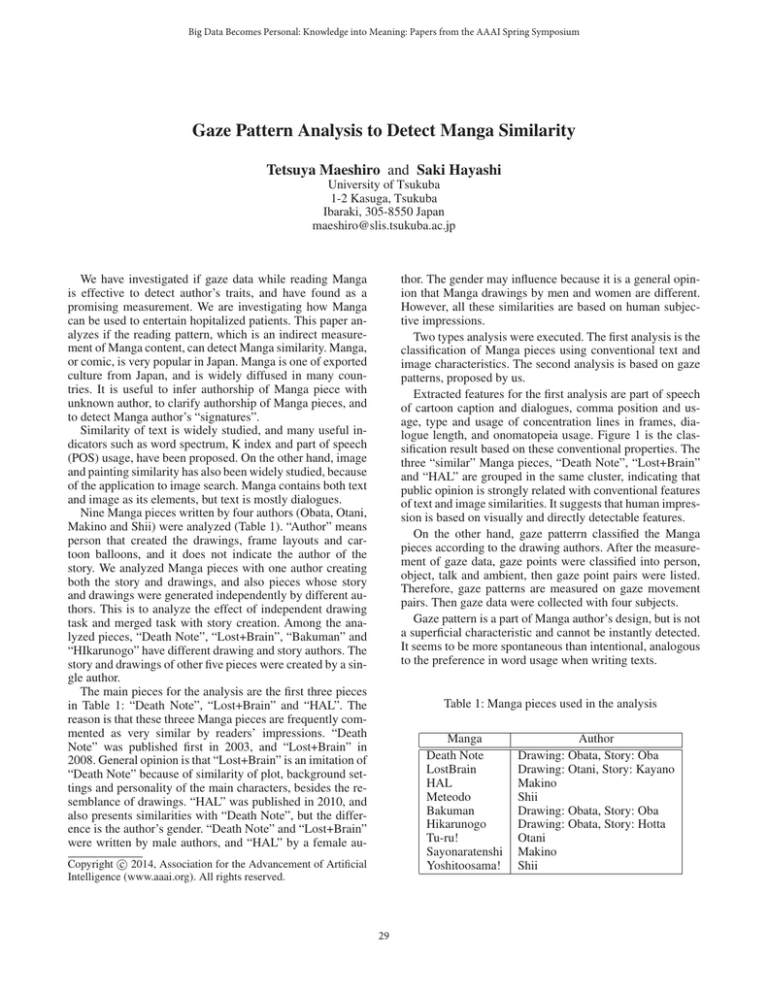
Big Data Becomes Personal: Knowledge into Meaning: Papers from the AAAI Spring Symposium Gaze Pattern Analysis to Detect Manga Similarity Tetsuya Maeshiro and Saki Hayashi University of Tsukuba 1-2 Kasuga, Tsukuba Ibaraki, 305-8550 Japan maeshiro@slis.tsukuba.ac.jp We have investigated if gaze data while reading Manga is effective to detect author’s traits, and have found as a promising measurement. We are investigating how Manga can be used to entertain hopitalized patients. This paper analyzes if the reading pattern, which is an indirect measurement of Manga content, can detect Manga similarity. Manga, or comic, is very popular in Japan. Manga is one of exported culture from Japan, and is widely diffused in many countries. It is useful to infer authorship of Manga piece with unknown author, to clarify authorship of Manga pieces, and to detect Manga author’s “signatures”. Similarity of text is widely studied, and many useful indicators such as word spectrum, K index and part of speech (POS) usage, have been proposed. On the other hand, image and painting similarity has also been widely studied, because of the application to image search. Manga contains both text and image as its elements, but text is mostly dialogues. Nine Manga pieces written by four authors (Obata, Otani, Makino and Shii) were analyzed (Table 1). “Author” means person that created the drawings, frame layouts and cartoon balloons, and it does not indicate the author of the story. We analyzed Manga pieces with one author creating both the story and drawings, and also pieces whose story and drawings were generated independently by different authors. This is to analyze the effect of independent drawing task and merged task with story creation. Among the analyzed pieces, “Death Note”, “Lost+Brain”, “Bakuman” and “HIkarunogo” have different drawing and story authors. The story and drawings of other five pieces were created by a single author. The main pieces for the analysis are the first three pieces in Table 1: “Death Note”, “Lost+Brain” and “HAL”. The reason is that these threee Manga pieces are frequently commented as very similar by readers’ impressions. “Death Note” was published first in 2003, and “Lost+Brain” in 2008. General opinion is that “Lost+Brain” is an imitation of “Death Note” because of similarity of plot, background settings and personality of the main characters, besides the resemblance of drawings. “HAL” was published in 2010, and also presents similarities with “Death Note”, but the difference is the author’s gender. “Death Note” and “Lost+Brain” were written by male authors, and “HAL” by a female au- thor. The gender may influence because it is a general opinion that Manga drawings by men and women are different. However, all these similarities are based on human subjective impressions. Two types analysis were executed. The first analysis is the classification of Manga pieces using conventional text and image characteristics. The second analysis is based on gaze patterns, proposed by us. Extracted features for the first analysis are part of speech of cartoon caption and dialogues, comma position and usage, type and usage of concentration lines in frames, dialogue length, and onomatopeia usage. Figure 1 is the classification result based on these conventional properties. The three “similar” Manga pieces, “Death Note”, “Lost+Brain” and “HAL” are grouped in the same cluster, indicating that public opinion is strongly related with conventional features of text and image similarities. It suggests that human impression is based on visually and directly detectable features. On the other hand, gaze patterrn classified the Manga pieces according to the drawing authors. After the measurement of gaze data, gaze points were classified into person, object, talk and ambient, then gaze point pairs were listed. Therefore, gaze patterns are measured on gaze movement pairs. Then gaze data were collected with four subjects. Gaze pattern is a part of Manga author’s design, but is not a superficial characteristic and cannot be instantly detected. It seems to be more spontaneous than intentional, analogous to the preference in word usage when writing texts. Table 1: Manga pieces used in the analysis Manga Death Note LostBrain HAL Meteodo Bakuman Hikarunogo Tu-ru! Sayonaratenshi Yoshitoosama! c 2014, Association for the Advancement of Artificial Copyright Intelligence (www.aaai.org). All rights reserved. 29 Author Drawing: Obata, Story: Oba Drawing: Otani, Story: Kayano Makino Shii Drawing: Obata, Story: Oba Drawing: Obata, Story: Hotta Otani Makino Shii Results show that within the analyzed pieces, authors have tendencies in preferred gaze movement pairs. Analysis indicate features with easy visual detection such as concentration lines, onomatopeia usage, dialogue quantities, are not useful to classify authors, but can be used to classify story genres such as sports, action, mystery, and so on. Figure 1: Dendrogram of clustering based on conventional text and drawing properties Although this is a preliminary study with small number of subjects and Manga pieces, the results suggest that measurement of human behavior related to Manga can indirectly determine the similarity among pieces. This is fundamentally different from direct analysis of the target object as in conventional research. This research measures indirectly the features inherent in target objects by measuring human reaction against the target objects. 30
